Traditional soap tools make better batches because they provide superior curing conditions and temperature control. Wooden molds offer ideal insulation and faster unmolding, while cast iron kettles distribute heat more evenly during saponification. Hand-carved cutters and vintage stamps add precision and character lacking in modern tools. You'll also get fewer air bubbles and lye pockets with wooden paddles. Discover why these time-tested implements elevate both the craft and quality of your handmade soaps.
Why Old-School Soap Tools Make Better Batches
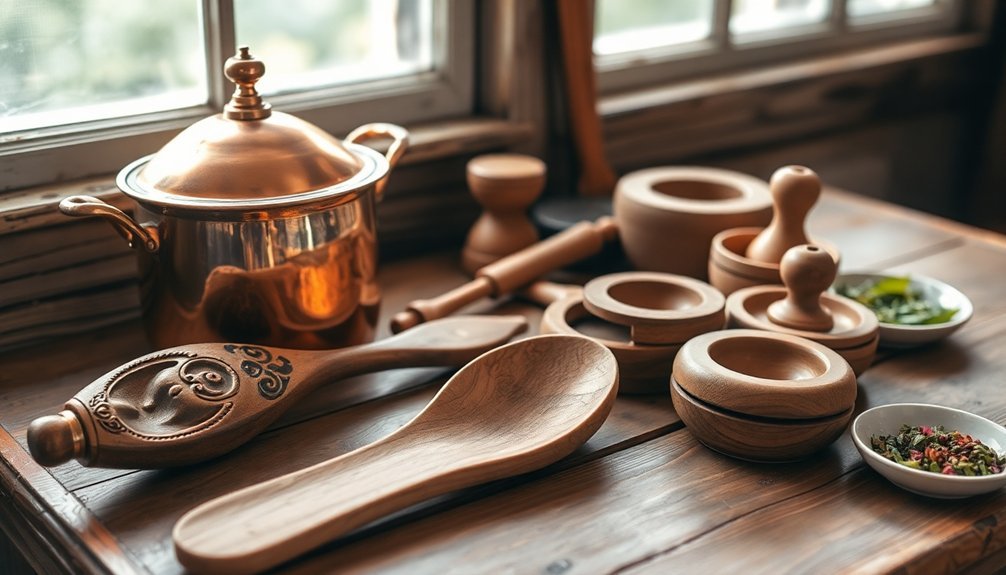
While many artisans have embraced modern equipment for soap making, traditional tools often yield superior results that modern counterparts simply can't match.
When you craft soap with time-tested implements, you're embracing the homesteading spirit that emphasizes resourcefulness and sustainability.
Traditional methods give you unparalleled control over your ingredients, allowing you to avoid unwanted additives while creating truly natural products.
You'll appreciate the cost-effectiveness of repurposing materials like tallow or lard from meals, reducing both waste and expenses.
The cold process method, facilitated by these traditional tools, preserves the natural glycerin that commercial soaps often remove.
The humble wooden spoon and simple mold preserve what factory processes strip away—the natural goodness your skin craves.
This results in a more moisturizing product without artificial detergents that can irritate sensitive skin.
Your customers will notice the difference in quality immediately.
Using a dedicated immersion blender for soap-making ensures no food contamination occurs and guarantees consistent, creamy lather in your final product.
Wooden Molds: The Secret to Perfect Curing Conditions
Among the traditional soap-making tools, wooden molds stand out for their exceptional ability to create perfect curing conditions.
These insulating powerhouses maintain consistent temperature and humidity throughout the curing process, ensuring your soap achieves a complete gel phase without additional heating equipment.
Unlike silicone alternatives, wooden molds offer benefits you'll immediately notice:
- Faster unmolding time – your soaps release more quickly under normal conditions
- Superior insulation – particularly valuable in colder or less humid environments
- Batch flexibility – easily accommodate both small and large production runs
- Cost effectiveness – with proper care (cleaning with alcohol, never immersing in water), these molds last for years
Most quality wooden molds come with removable ends that make extracting your finished soap much easier and less stressful.
Simply line with freezer paper, and you'll enjoy consistent, high-quality results that silicone molds can't match.
Cast Iron Kettles and Their Superior Heat Distribution
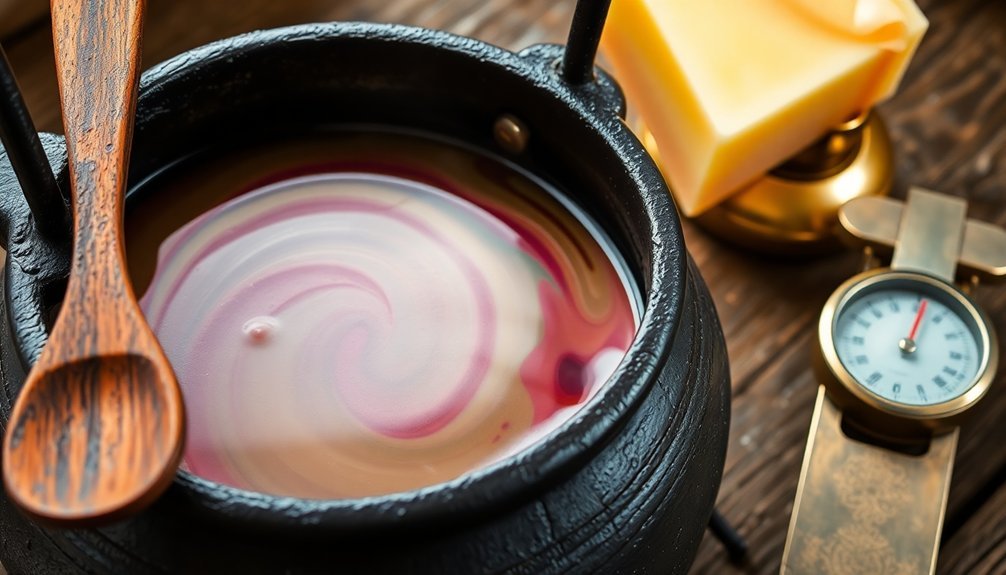
Since the earliest days of traditional soap-making, cast iron kettles have remained unmatched for their exceptional heat distribution capabilities. Their molecular structure efficiently transmits heat, ensuring your soap ingredients are heated evenly throughout the process.
You'll find that cast iron's remarkable thermal conductivity heats your soap mixtures faster while maintaining consistent temperatures longer—crucial for proper saponification. The crystalline ferrite structure allows for superior heat transmission, improving your soap's consistency. The kettle's durability means you won't need replacements like you'd with glass or porcelain alternatives.
When using your cast iron kettle, avoid soap for cleaning and dry it thoroughly to prevent rust.
For best results, pair it with a gas stove or induction cooktop, but avoid electric stoves. The robust construction not only improves your soap quality but adds a touch of authenticity to your craft.
Hand-Carved Soap Cutters for Precision and Character
Hand-carved soap cutters represent the perfect marriage of artistry and functionality in traditional soap-making. Unlike mass-produced alternatives, these durable wooden or metal tools give your soaps distinctive character while ensuring consistent results.
You'll notice the difference in both the process and final product.
When you invest in hand-carved cutters, you're gaining:
- Precision control over thickness and appearance, creating professional-looking bars every time
- Adaptability to various soap loaf sizes without needing standardized equipment
- Ergonomic handling that reduces fatigue during long cutting sessions
- Unique design elements that differentiate your products in the marketplace
The craftsmanship behind these tools translates directly to your soap's quality. Some premium cutters are handcrafted from premium pine and offer both wavy and straight cutting capabilities.
Many artisans appreciate that these cutters can be maintained for years, making them both environmentally and economically sensible for serious soap makers.
Antique Soap Stamps That Add Heritage Value
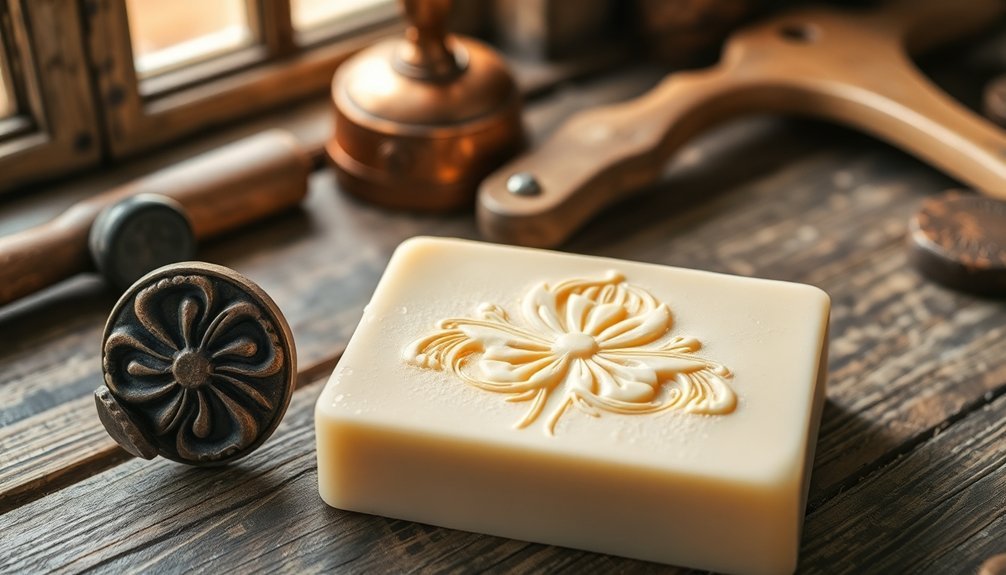
Antique soap stamps offer more than just a way to mark your creations—they infuse each bar with a sense of history and craftsmanship that modern alternatives simply can't match.
These brass, copper, or bronze treasures feature intricate designs that transform ordinary soap into artisanal masterpieces. You'll find these stamps create distinctive impressions that customers instantly recognize as handcrafted.
Their durable metal construction develops character over time, with patinas that enhance their vintage appeal. Beyond soap making, you can repurpose these versatile tools for wax sealing, wedding invitations, or paper crafts.
What's particularly valuable is their collectibility. Antique models like the Chinese Soapstones Figurine Wax Seal Stamp can fetch as much as $54.57 with free shipping. Each stamp carries its own story and heritage, making your soap products more appealing to customers who value tradition and uniqueness.
Your creations become conversation pieces that stand out in today's mass-produced marketplace.
Wooden Stirring Paddles: Better Trace Development
Wooden stirring paddles give you superior control over soap texture development while gently incorporating ingredients without disrupting delicate formulations.
You'll notice the natural insulation of wood provides balanced heat distribution throughout your mixture, preventing hot spots that can accelerate trace unevenly.
Traditional wood paddles connect you to centuries of soap-making wisdom while delivering practical benefits that plastic alternatives simply can't match. Their comfortable grip design reduces hand fatigue during extended stirring sessions required for perfect soap batches.
Consistent Texture Control
While many modern soapmakers reach for plastic or stainless steel tools, traditional wooden stirring paddles offer superior benefits for achieving that perfect trace.
These natural implements provide gentle, even mixing that's essential for developing consistent soap textures. The wooden paddles are also incredibly gentle on cookware, preserving your soap-making vessels for years of continued use.
When you're aiming for professional-quality results, wooden paddles deliver four key advantages:
- Even distribution of ingredients without disrupting the delicate saponification process
- Reduced air bubbles thanks to the gentle stirring motion that wooden paddles naturally encourage
- Perfect temperature control since wood doesn't conduct heat like metal tools
- Consistent color blending throughout your batch, eliminating streaks or uneven pigmentation
You'll find your soaps develop more predictable, smooth textures when wooden tools become your go-to mixing implements.
Gentle Ingredient Incorporation
For generations, artisan soapmakers have valued wooden stirring paddles specifically for their gentle touch during the critical ingredient incorporation phase.
These non-reactive tools promote slower, more controlled trace development while protecting delicate ingredients from damage.
You'll find wooden paddles create fewer air bubbles and allow more precise monitoring of your soap's consistency.
Unlike metal utensils that might scratch or plastic that could leach chemicals, wood maintains a reliable performance across different recipes.
This gentler mixing approach helps prevent lye pockets and guarantees uniform saponification throughout your batch.
However, you should regularly inspect wooden spoons for wear and discard them if they show signs of serious damage to prevent safety hazards during soap making.
Beyond performance benefits, choosing wooden stirrers connects you with soap-making traditions while supporting environmental sustainability through biodegradable, natural materials.
The craftsmanship involved with wooden tools enhances your soap's artisanal quality, creating a meaningful link between modern methods and historical techniques.
Heat Distribution Advantage
Unlike metal alternatives that rapidly conduct heat, wooden stirring paddles offer superior temperature regulation during the sensitive soap-making process.
You'll notice that woods like walnut and mahogany maintain consistent temperatures, helping you achieve that perfect trace development without overheating your batch. Traditional hardwoods such as maple provide additional benefits with their natural antibacterial properties that help maintain product purity throughout the process.
When using wooden paddles, you'll benefit from:
- Natural heat resistance that prevents burns when working with hot lye solutions
- Gentle mixing action that reduces air bubbles and creates clearer soap
- Controlled temperature that promotes ideal trace consistency and better lather
- Extended working time with your soap mixture before it sets
The insulating properties of wood mean your soap mixture cools gradually rather than suddenly, giving you more control over the vital trace development phase.
Traditional Lye Calculators vs. Digital Alternatives
Traditional lye calculators offer you a distinct tactile learning advantage that digital alternatives can't replicate, forcing you to understand each chemical calculation thoroughly.
Your manual precision with these tools creates a deeper connection to the soap-making process, particularly when measuring exact proportions of lye to fat ratios. Tools like the Majestic Mountain Sage Lye Calculator have been providing this hands-on experience as one of the first online calculators available.
While digital calculators streamline the process, mastering traditional calculation methods helps you identify and prevent common errors that might otherwise go unnoticed by automated systems.
Manual Precision Matters
While innovative digital tools have revolutionized soap making calculations, many artisans still depend on traditional lye calculators for their reliable precision.
You'll find that manual calculations foster a deeper understanding of the chemistry behind saponification, creating a connection to the craft that digital methods sometimes miss.
When considering manual precision advantages:
- Heightened awareness – Performing calculations by hand keeps you more attentive to slight variations in ingredient ratios.
- Direct control – You'll maintain complete oversight of superfatting adjustments without relying on preset algorithms.
- Consistent methodology – Your personal calculation system builds batch-to-batch consistency over time.
- Craft authenticity – The traditional approach preserves soap making's artisanal heritage and techniques.
This hands-on approach guarantees you're fully engaged with every aspect of your formulation process. Understanding the appropriate water/lye ratio ensures proper saponification, with 2:1 recommended for solid soap bars and 3:1 for liquid soap paste.
Tactile Learning Advantage
The tactile experience of handling manual lye calculators creates a unique learning pathway that digital alternatives simply can't replicate.
When you physically measure ingredients and feel the resistance of tools in your hands, your brain engages multiple sensory channels simultaneously.
You'll notice immediate feedback as you adjust measurements, helping you develop an intuitive understanding of soap chemistry. This hands-on approach enhances memory retention and improves your attention to detail in ways screen interactions never could.
Without technology dependencies, you're free to work anywhere while gaining a holistic understanding of the soap-making process.
The physical engagement promotes critical thinking as you experiment with ratios and solve problems in real-time.
These tactile experiences build mathematical literacy and chemical understanding that becomes deeply embedded in your craftsmanship. The manual process of soap making has been shown to significantly increase endorphin release, creating a natural sense of well-being while you craft.
Calculation Error Prevention
Two critical factors separate traditional lye calculators from their digital counterparts when preventing soap-making errors.
While digital tools offer precision, traditional methods teach you to understand the soap-making process at a deeper level, helping you spot potential issues before they occur.
When using traditional calculation methods, you'll develop:
- Intuitive knowledge – You'll learn to recognize when something feels off, even without digital validation.
- Troubleshooting skills – Manual calculations force you to understand what each ingredient contributes.
- Adaptation abilities – You'll become adept at adjusting recipes on-the-fly when needed.
- Consistency awareness – Traditional methods make you hyper-aware of batch variations, leading to better quality control.
These skills remain valuable even when you eventually incorporate digital tools into your workflow. While modern evaluation systems like those used for GPT models can assess performance with precision, they still benefit from the foundational understanding that traditional methods provide.
Vintage Drying Racks: Optimal Air Circulation Benefits
Historically valued for their ingenious design, vintage drying racks represent a pinnacle of functional craftsmanship in the soap-making industry. Their slotted bottoms and vented designs accelerate drying times by up to 25%, ensuring your soap cures evenly without the need to rotate bars.
Ingenious vintage drying racks: functional masterpieces that revolutionized soap curing through superior ventilation and thoughtful design.
You'll appreciate how these racks, often crafted from durable polyethylene or woods like redwood and oak, maximize your workspace through smart stackability—some designs reaching over 8 feet high. Modern innovations like Willow Way trays offer this same stackability with exclusive slot ventilation that promotes optimal airflow. This space efficiency translates directly to increased production capacity and reduced labor costs.
The ergonomic handling reduces fatigue while their broad temperature tolerance makes them versatile in various environments.
Whether you're making soap bars, bath bombs, or even candies, these adaptable workhorses prove that sometimes, traditional tools simply can't be improved upon.
Natural Fiber Brushes for Artisanal Design Techniques
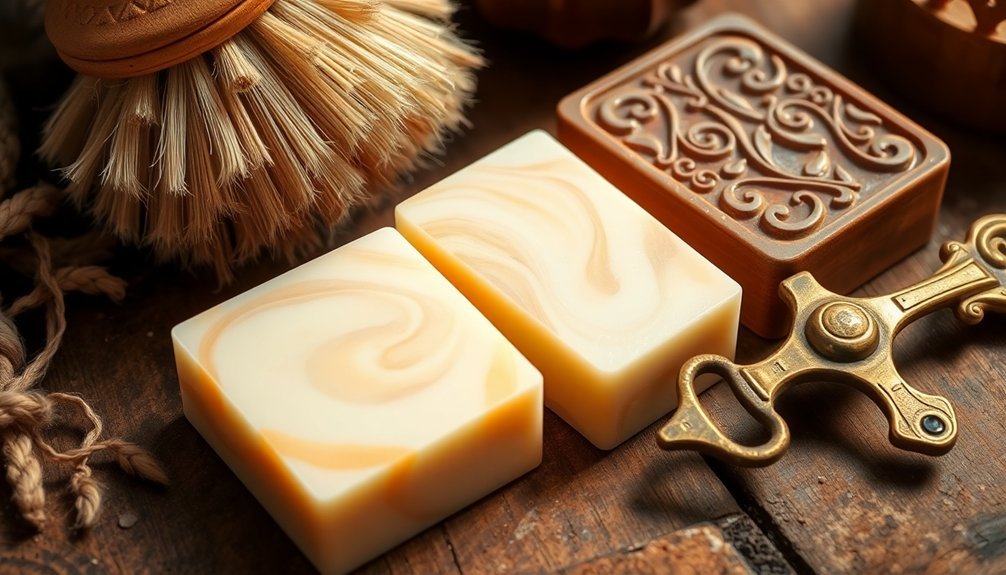
Natural fiber brushes offer you remarkable precision for creating intricate swirls and marbling effects that machine-made tools simply can't replicate.
You'll discover these traditional implements create distinctive textures by gently dragging fibers through soap at various stages of curing, leaving behind organic patterns impossible to achieve with synthetic alternatives.
Their eco-friendly composition aligns perfectly with natural soap making principles, allowing you to craft beautiful designs while maintaining environmental integrity throughout your entire production process. These brushes support the creation of customized soaps that cater to your specific skin types and personal preferences.
Precision Swirling Techniques
Artisanal soap makers have long relied on specialized natural fiber brushes to elevate their swirling techniques from basic to stunning.
These old-school tools offer control that modern alternatives simply can't match, especially when executing intricate designs.
For ideal results with your swirling techniques, consider these classic approaches:
- Master the Drop Swirl by varying your pouring height—higher pours create deeper patterns, while lower pours produce more defined swirls.
- Try the In-the-Pot Swirl when you want a blend of fine and thick patterns, adjusting trace consistency for different effects.
- Perfect your Taiwan Swirl using traditional wooden dividers for elegant designs that reveal themselves when cut horizontally.
- Experiment with the Hanger Swirl using simple wire tools for enchanting zig-zag patterns throughout your soap.
Always remember to prepare colors in separate containers before starting any swirling technique to ensure smooth execution and vibrant results.
Natural Texture Creation
While precision swirling creates visual appeal, the tactile dimension of artisanal soapmaking relies heavily on well-chosen natural fiber brushes.
These natural tools—crafted from sable, mongoose, or hog hair—offer distinct texturing capabilities that synthetic alternatives simply can't match.
You'll find that different fibers create unique effects: sable delivers smoother finishes while coarser hog bristles produce rustic textures perfect for impasto and drybrushing techniques.
Proper maintenance is essential; use mild soaps like Castile or specialized products such as Borciani Bonazzi to preserve your brushes' integrity.
Though initially more expensive, natural fiber brushes prove cost-effective long-term, especially when properly cleaned with pH-balanced soaps. Regular cleaning with B B Vegetale Soap prevents hardening and extends brush life significantly.
Their superior durability and expressive range make them indispensable for advanced textural techniques—from layering thick mixtures to creating delicate surface patterns that elevate your soap designs.
Eco-Friendly Pattern Making
Beyond traditional techniques, eco-friendly pattern making has revolutionized artisanal soap design through sustainable materials and methods.
When you choose natural fiber brushes for creating patterns, you're embracing both sustainability and superior craftsmanship.
Natural bristles from boar or sable offer unmatched durability and texture capabilities that synthetic alternatives simply can't replicate. These brushes align perfectly with cold process method which allows for greater customization in eco-friendly soap making.
Your soap designs benefit in four distinct ways:
- Enhanced longevity – Natural brushes maintain their quality longer, reducing replacement frequency
- Superior texture variety – Organic bristles create unique imprints impossible with synthetics
- Biodegradable materials – Less environmental impact when eventually disposed
- Artistic authenticity – Each stroke carries the unmistakable mark of traditional craftsmanship
Cold Process Wooden Troughs: Maintaining Ingredient Integrity
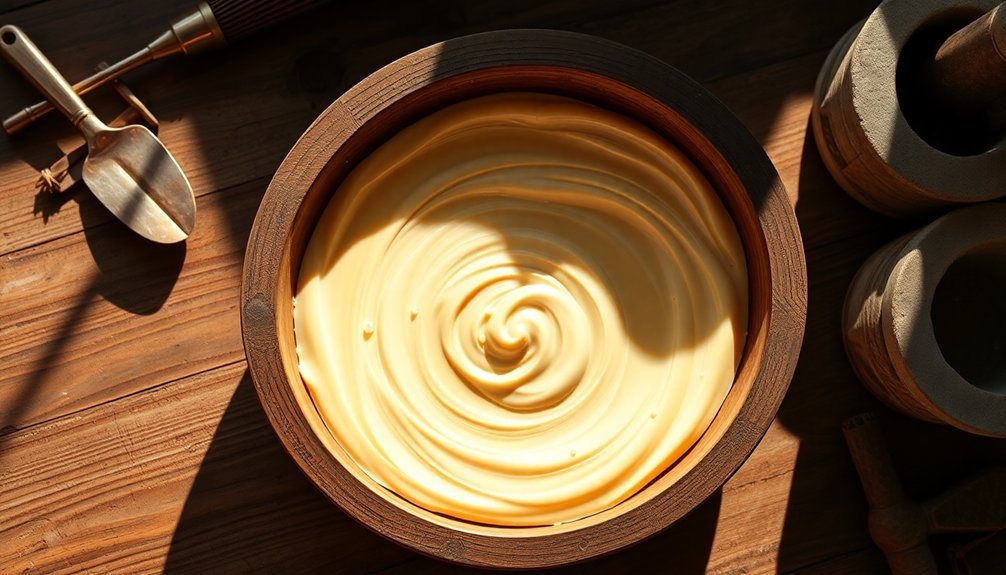
For serious soap crafters seeking to preserve the integrity of delicate ingredients, wooden troughs remain an unmatched traditional choice.
These molds excel at maintaining ideal temperatures that prevent honey, milk, and other sensitive additives from overheating during saponification.
You'll find wooden troughs particularly valuable when working with natural additives. Their superior insulation properties enhance the gel phase, ensuring thorough mixing and stable formulations.
Natural additives thrive in wooden troughs where superior insulation promotes ideal gel phases for stable, well-mixed formulations.
Unlike metal molds that react with lye or plastic options that can't handle higher temperatures, wood provides the perfect environment for your raw materials.
With customizable configurations, you can adjust your mold to accommodate specific recipe needs while maintaining consistent batch sizes. Their sturdy construction makes them perfect for cold process soaping, delivering reliable results that beginners and experts alike appreciate.
This attention to detail results in more reliable ingredient ratios and ultimately superior soap quality that modern alternatives simply can't match.
Frequently Asked Questions
Where Can I Source Authentic Vintage Soap-Making Tools?
You'll find authentic vintage soap-making tools at Etsy, antique shops, auction houses, historical reenactment groups, and farm supply stores. Contact collectors and join online forums dedicated to historical soap-making for more specialized equipment.
How Do I Restore and Maintain Antique Wooden Soap Molds?
To restore antique wooden soap molds, clean with 99% isopropyl alcohol, apply furniture polish for protection, and never immerse in water. Maintain them by drying thoroughly after use and storing in a moisture-free environment.
Are Traditional Soap Tools Food-Safe for Kitchen Soap Production?
Traditional soap tools can be food-safe if properly cleaned after use. You'll need to thoroughly sanitize stainless steel and glass items, while keeping wooden tools dedicated solely to soap making to prevent contamination.
What Safety Precautions Apply When Using Vintage Lye Handling Equipment?
When using vintage lye equipment, you'll need to verify it's not aluminum, wear protective gear, guarantee proper ventilation, inspect for damage, and keep vinegar nearby for neutralizing spills. Never repurpose these tools for food.
Can Traditional Tools Be Adapted for Large-Scale Commercial Production?
Yes, you can adapt traditional tools for commercial scale by adding drill attachments to blenders, upgrading to stainless steel pots, using HDPE molds, and investing in custom soap cutters for efficiency.
In Summary
You'll find that investing in traditional soap-making equipment isn't just about nostalgia—it's about quality. These time-tested tools create superior products with better texture, scent retention, and aesthetic appeal. While modern gadgets offer convenience, they can't replicate the character and craftsmanship that wooden molds, cast iron kettles, and hand tools bring to your soaps. Embrace these heritage techniques, and your customers will notice the difference.





Leave a Reply